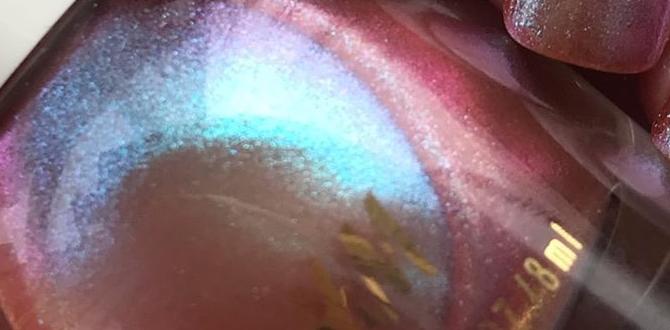Diy Nail Art Using Old Brushes: Effortless Designs for Stunning Manicures
Transforming old makeup brushes into stunning DIY nail art tools is surprisingly easy and budget-friendly! You don’t need fancy gadgets to create beautiful designs. With a little creativity and a few simple steps, you can turn those forgotten brushes into your go-to for intricate patterns, gradients, and more, giving your nails a professional, salon-worthy look right at home.
Have you ever looked at your collection of old makeup brushes and wondered if they could have a second life? Especially those smaller detail brushes or even a slightly fanned-out foundation brush? It turns out, they’re perfect for DIY nail art! Many of us keep a drawer full of these, perhaps hesitant to toss them but unsure of what else to do. If you’re looking for a simple, cost-effective way to elevate your manicure game, you’re in the right place. We’ll show you how to prep and use these brushes to create gorgeous, effortless nail art designs that will have everyone asking where you got your nails done.
Why Use Old Brushes for Nail Art?
It’s all about giving items a new purpose and saving money! Instead of buying specialized nail art brushes (which can add up!), you likely already own the perfect tools. Old makeup brushes, when cleaned and repurposed, offer a fantastic and sustainable way to explore your creativity on your nails. They are incredibly versatile, and you might be surprised at the intricate designs you can achieve.
What Kind of Old Brushes Work Best?
Not all old brushes are created equal for nail art. The best ones are typically smaller and have specific bristle shapes that lend themselves well to fine details, smudging, or filling in. Think about the types of designs you want to create when selecting your brushes.
- Detail & Liner Brushes: These are often the most versatile for fine lines, dots, and intricate patterns. Look for brushes with firm, pointed tips.
- Fan Brushes: Slightly fanned-out brushes are excellent for creating gradient or ombre effects, or for gently blending colors.
- Flat Shader Brushes (Small): A small, flat brush can be great for creating clean lines, geometric shapes, or even pushing glitter around.
- Round Brushes: Smaller round brushes are good for creating dots of various sizes or small floral elements.
- Lip Brushes: These are often fine-tipped and can be excellent for detailed work.
Preparing Your Old Brushes for Nail Art
This is a crucial step! You want to ensure your brushes are clean, sterile, and ready to pick up polish without smudging or leaving behind unwanted residue. Thorough cleaning is key to achieving crisp designs and preventing nail infections. Here’s how to get them ready:
Step 1: Deep Clean Your Brushes
This is the most important part. You need to remove all traces of makeup, oil, and old product. This ensures your nail polish adheres properly and prevents any cross-contamination.
- Initial Wash: Start by washing the brushes with warm water and a gentle soap or brush cleaner. Work the soap into the bristles, rinsing thoroughly until the water runs clear. Be careful not to soak the brush handles for too long, especially if they are wooden, as this can damage them.
- Stubborn Residue: For any stubborn pigments, a bit of rubbing alcohol can help. Dip the bristles in rubbing alcohol and swirl them on a clean paper towel.
- Sanitize: After washing and rinsing, it’s essential to sanitize them. You can do this by soaking the bristles briefly in rubbing alcohol (about 70% isopropyl alcohol is ideal). Swirl them for about 30 seconds.
- Rinse and Dry: Rinse the brushes thoroughly with cool water one last time to remove any alcohol residue. Gently squeeze out excess water and reshape the bristles.
- Air Dry: Lay the brushes flat on a clean paper towel or hang them bristles-down (using a brush holder or a rubber band around the handle and hanging off an edge) to air dry completely. Never use heat, as this can damage the bristles.
Step 2: Trim and Reshape (Optional)
If any bristles are bent, splayed out, or uneven, you can carefully trim them with small, sharp scissors to create a sharper point or a cleaner edge. This is especially helpful for liner-style brushes.
Step 3: Storage
Once completely dry, store your repurposed brushes in a clean, dry place. A small pencil case, a dedicated brush holder, or even an old mug works well. Keeping them clean and separated will help them last longer and maintain their shape.
Essential Nail Art Tools & Supplies
Beyond your old brushes, you’ll need a few basic nail art supplies. Most of these are standard nail polish items you might already have. Having these on hand will make your DIY nail art sessions much smoother!
| Item | Purpose |
|---|---|
| Base Coat | Protects your nails and provides a smooth canvas. |
| Top Coat | Seals your design, adds shine, and prevents chipping. |
| Nail Polish Colors | Your chosen shades for the base and design. Lighter opacity polishes can be easier for beginners. |
| Palette/Surface | A piece of foil, a tile, or an old CD/DVD to put small amounts of polish on for dipping your brush. |
| Rubbing Alcohol (70% Isopropyl) | For cleaning brushes and creating special effects. |
| Cotton Swabs/Pads | For cleaning up mistakes. |
| Nail Polish Remover | Good for more significant clean-up. |
Effortless DIY Nail Art Designs Using Old Brushes
Now for the fun part! Here are some beginner-friendly designs you can create using your repurposed brushes. Remember to work on a clean, dry nail base and to have your palette (foil, tile, etc.) ready with a small amount of polish for your brush to pick up.
Design 1: The Simple Dot & Dash
This is perfect for practicing your brush control and creating charming, minimalist designs. It’s incredibly versatile and can be done with almost any fine-tipped brush.
Tools Needed:
- Fine-tipped detail brush (from old makeup brushes)
- Base coat, top coat, and your chosen polish colors
- Palette
- Rubbing alcohol for brush cleaning
Steps:
- Apply Base Coat: Start with a clean nail, apply a thin layer of base coat, and let it dry completely.
- Apply Basic Polish: Paint your nails with your desired base color. Let it dry thoroughly. You might need two coats for opacity, ensuring each coat is dry before proceeding.
- Load Your Brush: Put a tiny dot of your accent color onto your palette. Dip the tip of your fine brush into the polish. You only need a small amount.
- Create Dots: Gently touch the tip of the brush to your nail to create a dot. You can make them in a line, a cluster, or scattered randomly. Clean your brush on a paper towel and dip for each dot.
- Create Dashes/Lines: For dashes or lines, load your brush with polish and try to drag it gently across the nail. Start with short, thin lines.
- Clean Up: Use a cotton swab dipped in nail polish remover to clean up any stray marks around your cuticles.
- Apply Top Coat: Once your design is completely dry, finish with a layer of top coat for shine and durability.
Tip: For perfectly even dots, you can use the rounded end of a bobby pin or a toothpick, but your brush will offer more control for varying sizes and placements.
Design 2: The Gradient Ombre Effect
This technique creates a beautiful blend of colors that looks super chic. A fanned-out or slightly stiff flat brush works surprisingly well for this.
Tools Needed:
- Fan brush or a small, flat shader brush (from old makeup brushes)
- Two or three complementary nail polish colors
- Base coat, top coat
- Palette
- Small cup of rubbing alcohol (just for the brush)
Steps:
- Prep Nails: Apply base coat and your lightest chosen color as the base layer. Let it dry.
- Apply Colors to Palette: Place thin lines of your two or three chosen colors side-by-side on your palette.
- Load Your Brush: Lightly dip your fan brush or flat brush into the colors on the palette. You want to pick up a little bit of each color.
- Blend on Nail: Gently swipe the brush across your nail in a horizontal or vertical motion. The idea is to drag the colors and blend them. Don’t press too hard. You may need to reload and re-swipe a few times to get the desired blend.
- Clean Brush Tip: After each swipe or two, dip the very tip of your brush into rubbing alcohol and wipe it on a paper towel to clean off excess polish. This prevents muddying the colors.
- Build Intensity: Apply additional thin layers if the blend isn’t strong enough, ensuring some drying time in between.
- Clean Edges: Use a cotton swab dipped in nail polish remover to clean up any polish that got onto your skin.
- Seal with Top Coat: Once happy with the blend and fully dry, apply a generous top coat to meld the colors together and add shine.
External Resource: For more on color theory and blending techniques, explore resources like The National Gallery of Art’s Color Theory Basics.
Design 3: The Abstract Swirl
This design is all about embracing imperfection and creating a unique, artistic look. A slightly stiffer, flat brush can be great for swirling colors.
Tools Needed:
- Small flat shader brush (from old makeup brushes) or a medium-sized round brush
- Two or three contrasting nail polish colors
- Base coat, top coat
- Palette
Steps:
- Base Layer: Apply your base coat and let it dry. Then, apply your main color and let it dry completely.
- Apply Polish to Palette: Place a few small dots of your accent colors onto your palette.
- Load Your Brush: Dip your brush into one of the accent colors.
- Create Swirls: Gently drag the brush through the accent color(s) on the palette if using multiple, then lightly touch and swirl onto your nail. Don’t overdo it! The goal is a few elegant, flowing lines. You might want to dab a bit of one color, then pick up another and swirl it in.
- Add Depth: You can add tiny dots or thin lines with a detail brush to enhance the swirl pattern if you wish.
- Clean Up: Use your cleanup brush (a flat brush dipped in remover) to refine the edges if needed.
- Top Coat: Once dry, seal the design with a clear top coat.
Design 4: Stamping-Inspired Texture
While not true stamping, you can mimic the effect by using a brush to dab or press polish onto your nail in patterned ways.
Tools Needed:
- A firm, flat brush or a stiff detail brush
- Base coat, top coat
- Polish colors
- Palette
Steps:
- Base Polish: Apply your base coat and a solid color to your nails, letting them dry.
- Load Brush: Dip your brush into an accent color.
- Dab or Press: For a dotted effect, dab the brush onto your nail in a pattern. For a more textured, almost brushstroke look, press and slightly drag the brush.
- Experiment: Try different degrees of pressure and angles to see what interesting textures you can create.
- Clean Up: Tidy up edges with remover.
- Top Coat: Apply top coat and admire your work!
Tips for Success with DIY Nail Art Brushes
Getting the hang of using old brushes for nail art is all about practice and a few smart tricks. Don’t get discouraged if your first attempt isn’t perfect. Every stroke is a learning opportunity!
- Work in Thin Layers: This is key to avoiding clumping and ensuring your polish dries properly.
- Less is More: Start with a small amount of polish on your brush. You can always add more, but it’s harder to remove excess.
- Clean Your Brush Frequently: After every couple of applications, clean your brush on a paper towel. If you’re switching colors, or if the polish starts to get gummy, a quick dip in rubbing alcohol (and a wipe) will refresh it.
- Patience with Drying Time: Make sure each layer of polish and design is reasonably dry before adding the next. This prevents smudging and makes clean-up easier.
- Don’t Be Afraid of Clean-up: A small brush or a pointed cotton swab dipped in nail polish remover is your best friend for tidying up stray marks.
- Practice on Paper First: Before committing to your nails, try out a design on a piece of paper or cardstock to get a feel for how your brush handles the polish.
Maintaining Your DIY Nail Art Brushes
To keep your repurposed brushes in great condition for future nail art adventures, follow these simple maintenance tips:
| Maintenance Step | Frequency | Why It’s Important |
|---|---|---|
| Remove excess polish | After each use | Prevents hardening and clumping of polish in bristles. |
| Wipe with alcohol/cleaner | Periodically during use, and after detailed sessions | Keeps bristles clear of dried polish and sanitized. |
| Deep Clean | As needed, or after long breaks | Ensures hygiene and ideal performance for future designs. |
| Reshape bristles | After washing | Maintains the brush’s effectiveness for specific design types. |
| Store properly | Always | Protects bristles from damage, dust, and keeps them organized. |
Beyond the Basics: Advanced Techniques
Once you’re comfortable with the foundational designs, you can start experimenting! Your old brushes can be used for a variety of advanced techniques:
- Marble Effects: Use thin lines of polish and a detail brush to create swirling marble patterns.
- Floral Elements: A fine-tipped brush can be used to draw petals, leaves, and centers for simple flowers.
- Geometric Patterns: With a steady hand and a flat brush, you can create sharp lines and squares for modern geometric looks.
- Water Marbling (with caution): While not typical, a fan brush can sometimes be used to gently swirl polish in water if you’re careful. If you’re interested in water marbling, it’s best to look into dedicated water marbling tools and techniques like those described by reputable beauty sites.
Remember, the key to mastering these techniques is practice. Don’t be afraid to combine different brush types and colors to discover your unique style. You can find endless inspiration on platforms like Pinterest and Instagram by searching for #nailart or #diynails.
FAQ: Your Nail Art Questions Answered
Q1: Can I really use any old makeup brush for nail art?
While most can be repurposed, brushes with fine tips, flat edges, or fan shapes tend to be the most versatile. Avoid brushes with very loose or fluffy bristles, as they won’t offer enough control for detailed work.
Q2: How do I prevent my nail polish from drying too quickly on the brush?
Always work with a small amount of polish on your palette. If the polish starts to thicken on the brush, quickly dip the tip into a tiny amount of rubbing alcohol, wipe it clean on a paper towel, and then reload with fresh polish. This also helps keep the brush sanitized.
Q3: What if I mess up a design?
A pointed cotton swab or a fine detail brush dipped in nail polish remover is your best friend! Gently and carefully use it to clean up any stray polish around




